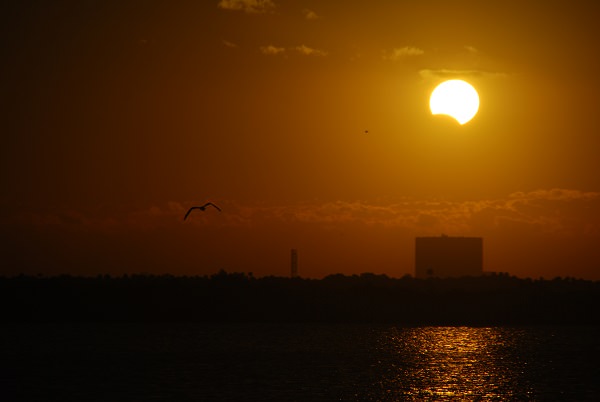Get those solar viewers out… the final eclipse of 2014 occurs this Thursday on October 23rd, and most of North America has a front row seat. Though this solar eclipse will be an exclusively partial one as the Moon takes a ‘bite’ out the disk of the Sun, such an event is always fascinating to witness. And for viewers across the central U.S. and Canada, it will also provide the chance to photograph the setting crescent Sun along with foreground objects.
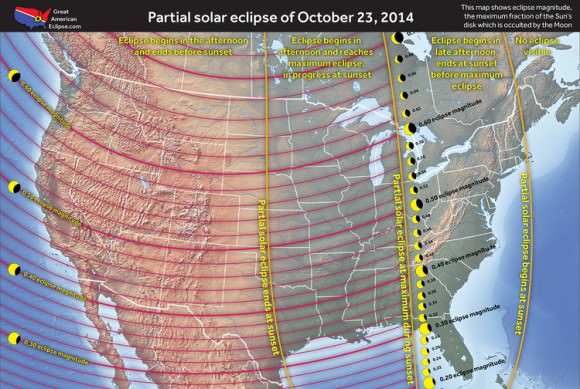
The shadow or ‘antumbra’ of the Moon just misses northern limb of the Earth on October 23rd, resulting in a solar eclipse that reaches a maximum of 81% partial as seen from the high Canadian Arctic. The eclipse would be annular in any event had the Moon’s shadow touched down on Earth’s surface, as the Moon just passed apogee on October 18th. The penumbral cone of the Moon’s shadow touches down at 19:38 UT in the Bering Sea just west of the International Date Line before racing eastward across North America to depart the Earth over southern Texas at 23:52 UT.
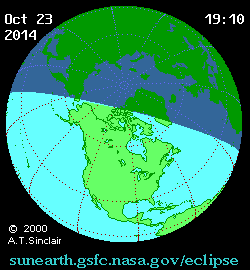
The farther northwest you are, the greater the eclipse: For example, Anchorage and Seattle will see 54.8% and 54.5% of the Sun obscured by the Moon, while Mexico City and Phoenix, Arizona will see 4.8% and 33% of the Sun’s disk obscured.
A key region will be the zone of longitude running a few hundred miles east and to the west of Ontario, the Great Lakes and the Mississippi River, which will see the Sun setting during greatest eclipse.
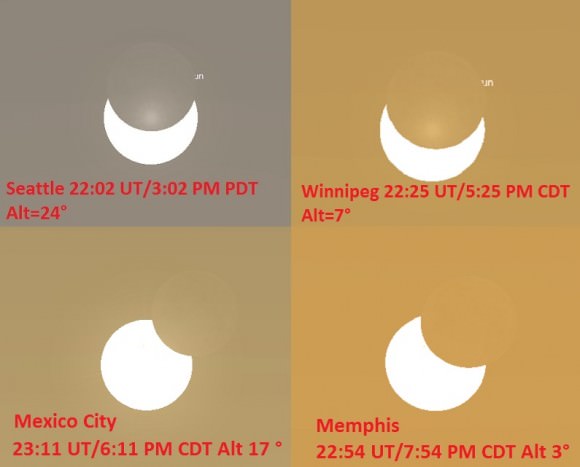
Successful sunset viewing of the eclipse will call for a clear, uncluttered western horizon. As of 48+ hours out, the current weather prospects call for clear skies across most of the U.S. on Thursday, with the exception of the U.S. northwest… but you only need a gap in the clouds to observe an eclipse!
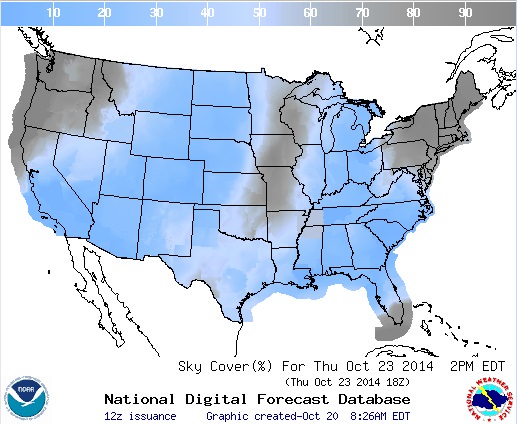
It’s also worth noting that massive sunspot region AR 2192 is currently turned Earthward and will make for a very active and photogenic Sun during Thursday’s eclipse.

Proper safety precautions must be taken while observing the Sun through all stages of a partial solar eclipse. Don’t end up like 19th century psychologist Gustav Fechner, who blinded himself staring at the Sun! With the recent interest in the event, we’ve been fielding lots of questions on eclipse imaging, which presents safety challenges of its own.
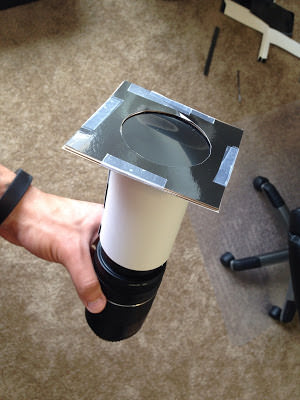
Imaging the Sun with a solar filter is pretty straightforward. Glass solar filters for telescopes fitting over the full aperture of the instrument can be had from Orion for about $100 USD, and we’ve made inexpensive filter masks out of Baader AstroSolar Safety Film for everything from binoculars to DLSR cameras to telescopes. Make sure these fit snugly in place, and inspect them for pin holes prior to use. Also, be sure to cover or remove any finderscopes as well. And throw away those old screw-on eyepiece filters sold by some department store scope manufacturers in the 60s and 70s, as they can overheat and crack!
Catching the eclipsed Sun with a silhouetted foreground requires more practice. We’ve had great luck using a DSLR and a neutral density filter to take the f-stop and glare down while preserving the foreground view. Remember, though, an ND filter is for photographic use only… never stare at the Sun through one! Likewise, you’ll need to physically block off your camera’s viewfinder to resist the same temptation of looking while aiming. Shooting several quick frames at 1/1000th of a second or faster will help get the ISO/f-stop settings for the local illumination just right. Even 1% sunlight is surprisingly bright, as we noticed observing the May 10th 1994 annular eclipse from the shores of Lake Erie.
You’ll also need a lens with a focal length of 200mm or better to have the Sun appear larger than a dot in your images. Several key landmarks, such as the Saint Louis Arch and the Sears Tower in Chicago lie along the key sunset zone Thursday and would make great potential foreground shots… our top pick would be the 1978 World’s Fair Sunsphere Tower in Knoxville, Tennessee for a photo with a true visual double entendre. Scout out the geometry of such a shot the evening beforehand, and remember that you’ll need a good amount of distance (half a mile or more) for a building or foreground object to appear equal in size to the Sun.
And don’t miss the spectacle going on around you during an eclipse as well. Projecting the disk of the Sun using a pinhole camera or binoculars onto a piece of paper makes for a great shot. Hundreds of crescents may litter the ground, caused by natural “pinhole projectors” such as gaps in leaves or latticework. And photographs of everyday folks wearing eclipse glasses standing enthralled by the ongoing event can be just as captivating as the eclipse itself.
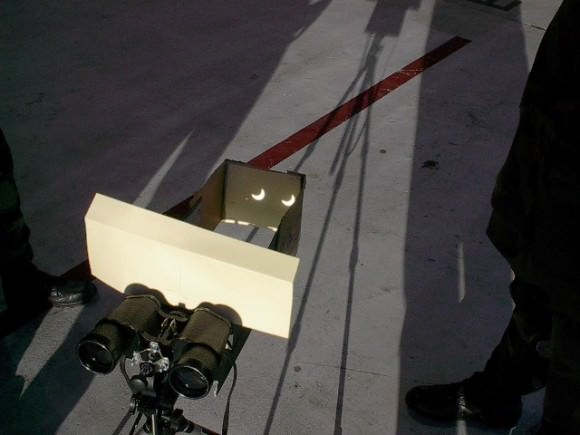
Up for a challenge? Another unique opportunity awaits eclipse viewers in the northwest, as the International Space Station will cross the disk of the Sun around ~21:08 UT during the eclipse. You’ll need to run video to catch such a speedy (about a second in duration) event, but it would make for a great capture! Be sure to check CALSky for predictions of ISS solar and lunar transits within 48 hours of the event.
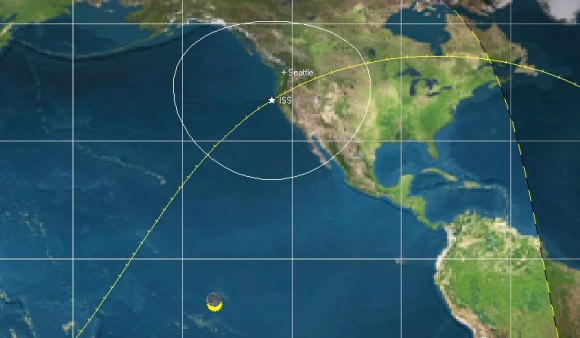
Robotic eyes in low Earth orbit will be watching the eclipse as well. JAXA’s Hinode and ESA’s Proba-2 routinely observe the Sun and will catch fleeting eclipses on successive passes on Thursday… in the case of Hinode, it may score a direct “hit” with an annular eclipse seen from space around 21:03 UT:
And don’t forget, we’re now less than three years out from the next total solar eclipse to (finally!) grace the United States from coast to coast on August 21st, 2017. This week’s partial solar eclipse offers a great test run to hone your photographic technique!
-Send those eclipse pics in to Universe Today’s Flickr forum.

